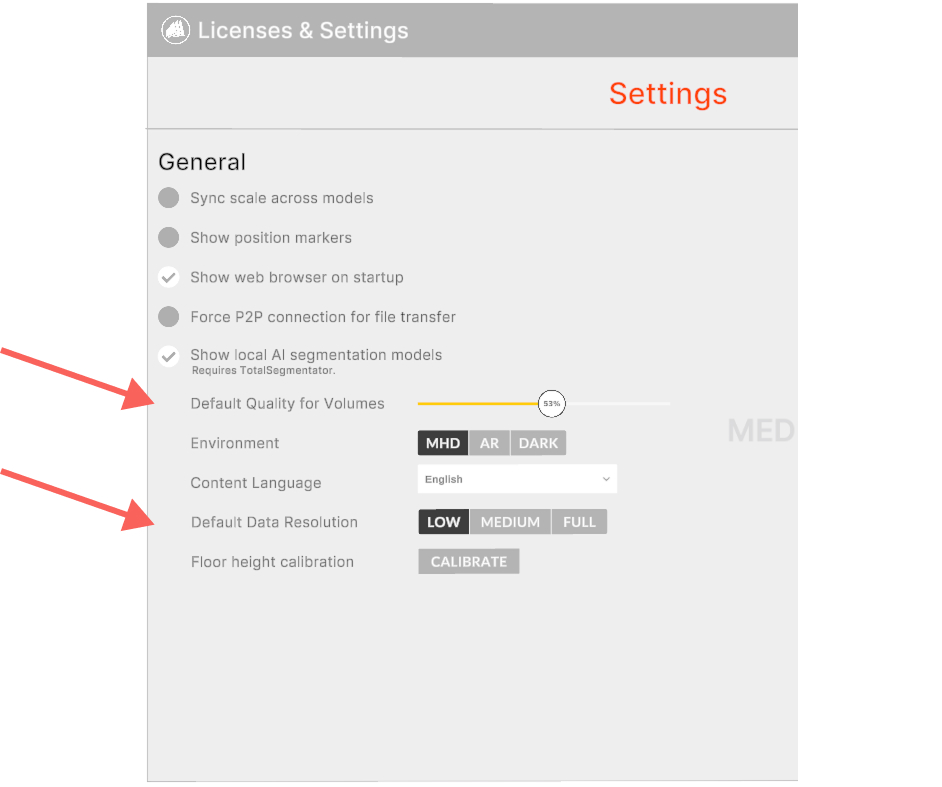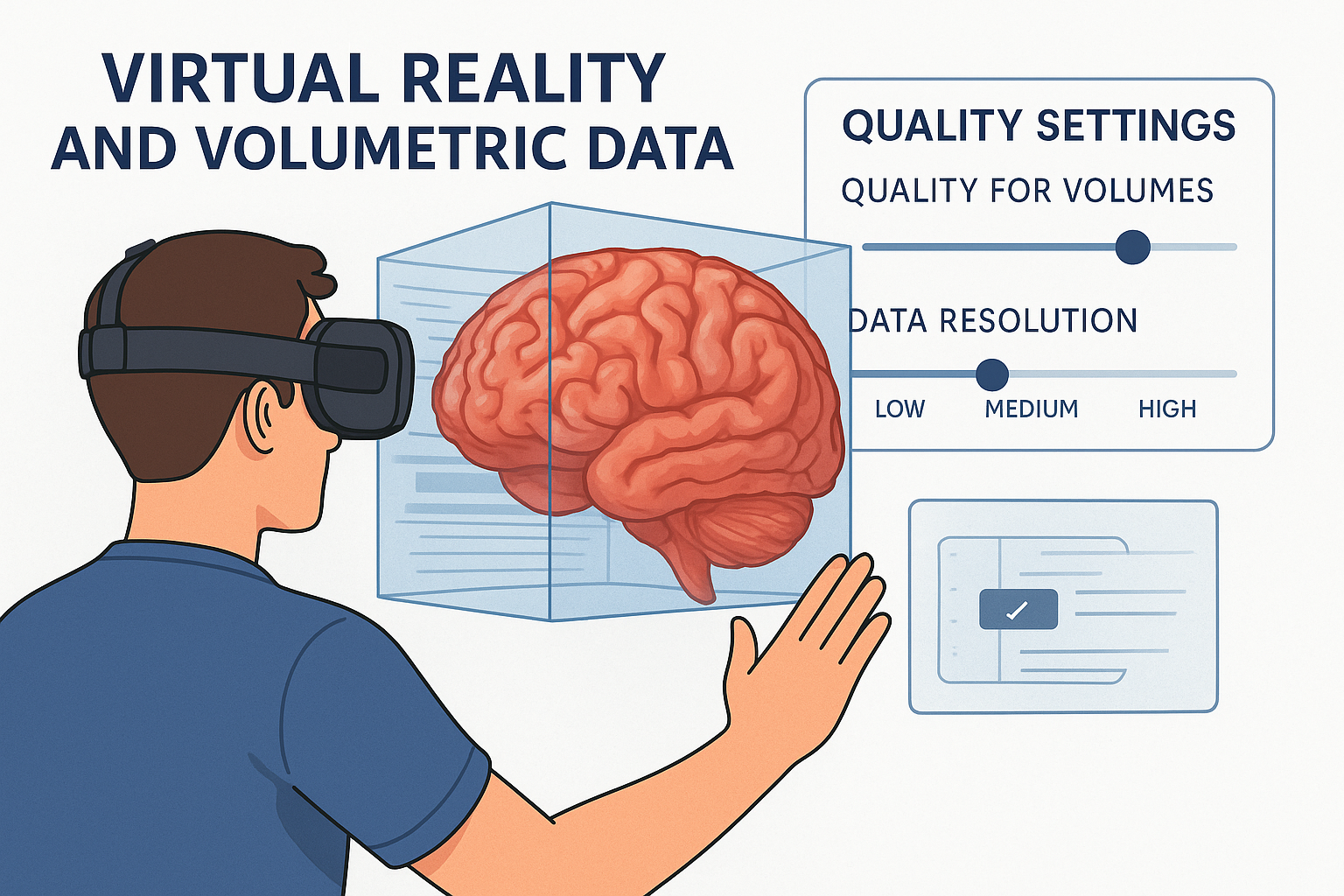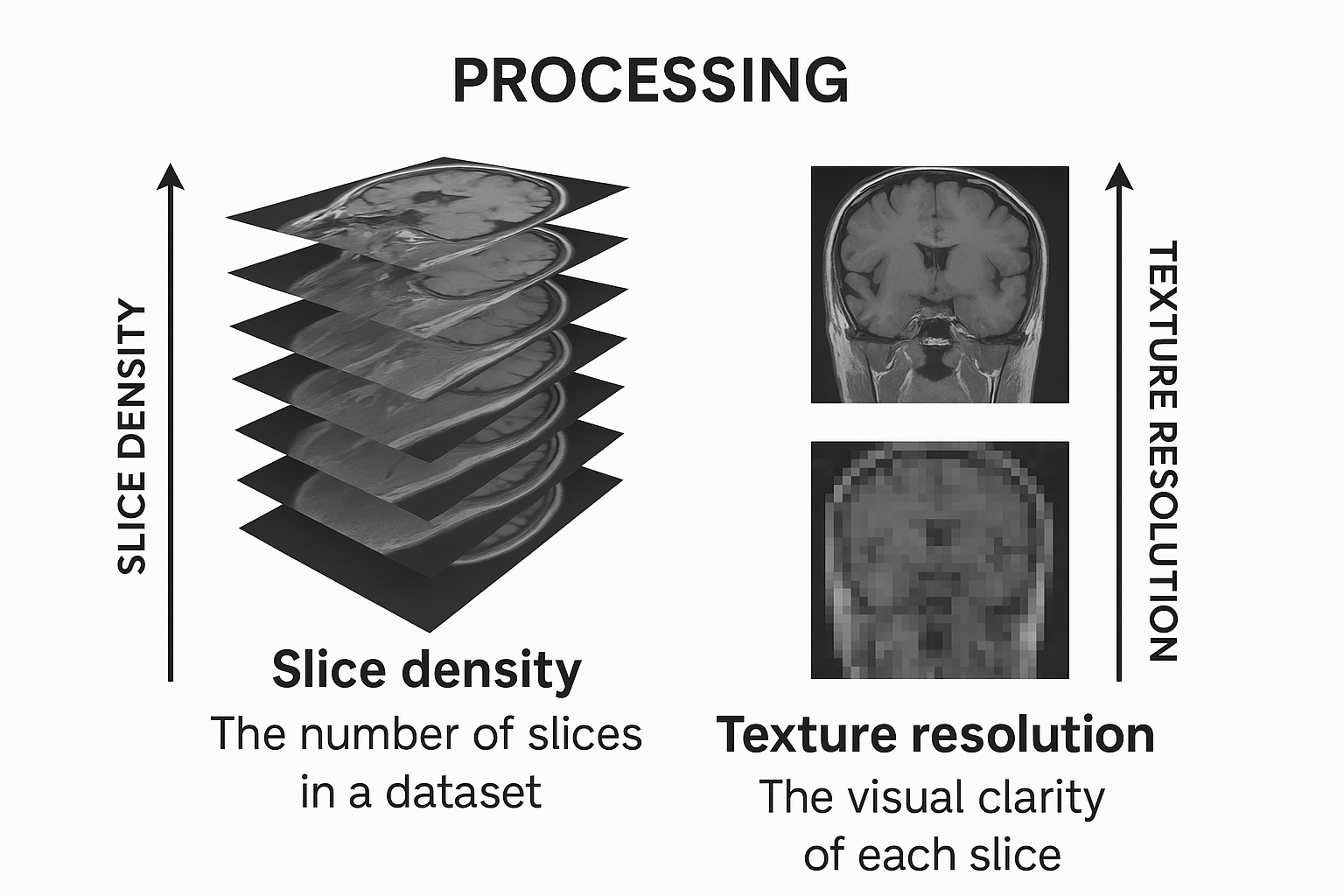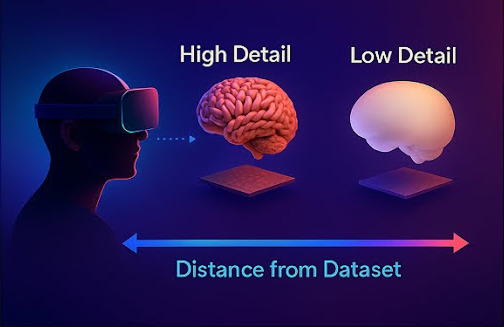Medical imaging quality settings
Imagine stepping inside a patient’s body to examine their CT or MRI
scan from the inside out - Virtual Reality is turning that into a
reality. But to make this immersive experience seamless and effective,
especially in VR, it's essential to understand how volumetric data is
processed and how quality settings influence rendering performance.
Medical imaging settings in Medicalholodeck
You can set default rendering options in the settings panel on the
left. Use the quality for volumes slider to adjust the density of the
volume. Select the data resolution setting to choose between low,
medium, or high texture quality. These settings will be applied when you
load a new model from the library.Medicalholodeck’s recommended defaults
are 10–14% volume quality and medium resolution for headsets, and 50%
volume quality with full resolution for PCs.
 These settings can also be adjusted for each individual model. Look for
quality for volumes and data resolution at the bottom of the Medical
Imaging XR panel, numbers 6 and 7.
These settings can also be adjusted for each individual model. Look for
quality for volumes and data resolution at the bottom of the Medical
Imaging XR panel, numbers 6 and 7.

 Low framerate screen
You can monitor your device's frames per second (FPS) in the top-right
corner of the object pad. If the frame rate drops below 10 FPS, a low
FPS warning screen appears as a protective measure. It gives your device
time to recover before becoming unresponsive or overheating. It also
signals that rendering quality may need to be lowered or the workspace
optimized. This screen isn't just a warning-it’s a safeguard against
crashes and a prompt to maintain system stability.
Low framerate screen
You can monitor your device's frames per second (FPS) in the top-right
corner of the object pad. If the frame rate drops below 10 FPS, a low
FPS warning screen appears as a protective measure. It gives your device
time to recover before becoming unresponsive or overheating. It also
signals that rendering quality may need to be lowered or the workspace
optimized. This screen isn't just a warning-it’s a safeguard against
crashes and a prompt to maintain system stability.
 When this screen appears, you can:
When this screen appears, you can:
 What is volumetric data?
Volumetric data represents 3D anatomical structures by stacking 2D
image slices, typically obtained through CT or MRI scans. Each slice
captures a thin cross-section of the body at specific intervals. When
combined these slices form a full 3D volume. These datasets are usually
stored in the DICOM format, which includes both the images and the
metadata needed to interpret them properly.
What is volumetric data?
Volumetric data represents 3D anatomical structures by stacking 2D
image slices, typically obtained through CT or MRI scans. Each slice
captures a thin cross-section of the body at specific intervals. When
combined these slices form a full 3D volume. These datasets are usually
stored in the DICOM format, which includes both the images and the
metadata needed to interpret them properly.
 From slices to 3D visualization: processing and texturing
Visualizing volumetric data in VR involves sophisticated processing
techniques. Texture maps are applied to each 2D slice, and algorithms
interpolate between them to generate a smooth, continuous 3D
representation. The more slices included-and the higher their
resolution-the more detailed the final rendering. However, this
increased fidelity comes with a computational cost.
Processing involves two key factors:
From slices to 3D visualization: processing and texturing
Visualizing volumetric data in VR involves sophisticated processing
techniques. Texture maps are applied to each 2D slice, and algorithms
interpolate between them to generate a smooth, continuous 3D
representation. The more slices included-and the higher their
resolution-the more detailed the final rendering. However, this
increased fidelity comes with a computational cost.
Processing involves two key factors:
 Challenges with large datasets in VR
Unlike conventional 2D image viewing, real-time 3D rendering in VR must
maintain high frame rates (ideally 60 FPS on a PC, 30 on a standalone
headset) to prevent motion sickness and ensure a smooth experience.
Large volumetric datasets, while visually impressive, can overwhelm
hardware if not managed properly. The larger the dataset - in physical
dimensions, not just file size - the more processing power is required
to render it effectively. This is where smart optimization and quality
settings become essential.
Adaptive detail rendering
To balance performance with visual quality, VR systems use level of
detail (LOD) techniques that adjust rendering based on the user’s
distance from the dataset. When the user is close, the system displays
high detail; when farther away, it switches to lower-resolution
textures, since fine details aren’t noticeable at a distance. This
approach preserves meaningful content while optimizing performance.
Challenges with large datasets in VR
Unlike conventional 2D image viewing, real-time 3D rendering in VR must
maintain high frame rates (ideally 60 FPS on a PC, 30 on a standalone
headset) to prevent motion sickness and ensure a smooth experience.
Large volumetric datasets, while visually impressive, can overwhelm
hardware if not managed properly. The larger the dataset - in physical
dimensions, not just file size - the more processing power is required
to render it effectively. This is where smart optimization and quality
settings become essential.
Adaptive detail rendering
To balance performance with visual quality, VR systems use level of
detail (LOD) techniques that adjust rendering based on the user’s
distance from the dataset. When the user is close, the system displays
high detail; when farther away, it switches to lower-resolution
textures, since fine details aren’t noticeable at a distance. This
approach preserves meaningful content while optimizing performance.

 These settings can also be adjusted for each individual model. Look for
quality for volumes and data resolution at the bottom of the Medical
Imaging XR panel, numbers 6 and 7.
These settings can also be adjusted for each individual model. Look for
quality for volumes and data resolution at the bottom of the Medical
Imaging XR panel, numbers 6 and 7.

 Low framerate screen
You can monitor your device's frames per second (FPS) in the top-right
corner of the object pad. If the frame rate drops below 10 FPS, a low
FPS warning screen appears as a protective measure. It gives your device
time to recover before becoming unresponsive or overheating. It also
signals that rendering quality may need to be lowered or the workspace
optimized. This screen isn't just a warning-it’s a safeguard against
crashes and a prompt to maintain system stability.
Low framerate screen
You can monitor your device's frames per second (FPS) in the top-right
corner of the object pad. If the frame rate drops below 10 FPS, a low
FPS warning screen appears as a protective measure. It gives your device
time to recover before becoming unresponsive or overheating. It also
signals that rendering quality may need to be lowered or the workspace
optimized. This screen isn't just a warning-it’s a safeguard against
crashes and a prompt to maintain system stability.
 When this screen appears, you can:
When this screen appears, you can:
- Continue if your device can handle it.
- Or remove all data to lighten the load.
- 50% Setting: All original slices from the DICOM dataset are used. This provides a faithful representation without interpolation.
- >50% Setting: The system begins to generate additional slices using interpolation algorithms, effectively increasing density beyond the original dataset. This can enhance detail but increases processing demands massively.
- <50% Setting: Fewer slices are used, reducing visual fidelity but improving performance.
 What is volumetric data?
Volumetric data represents 3D anatomical structures by stacking 2D
image slices, typically obtained through CT or MRI scans. Each slice
captures a thin cross-section of the body at specific intervals. When
combined these slices form a full 3D volume. These datasets are usually
stored in the DICOM format, which includes both the images and the
metadata needed to interpret them properly.
What is volumetric data?
Volumetric data represents 3D anatomical structures by stacking 2D
image slices, typically obtained through CT or MRI scans. Each slice
captures a thin cross-section of the body at specific intervals. When
combined these slices form a full 3D volume. These datasets are usually
stored in the DICOM format, which includes both the images and the
metadata needed to interpret them properly.
 From slices to 3D visualization: processing and texturing
Visualizing volumetric data in VR involves sophisticated processing
techniques. Texture maps are applied to each 2D slice, and algorithms
interpolate between them to generate a smooth, continuous 3D
representation. The more slices included-and the higher their
resolution-the more detailed the final rendering. However, this
increased fidelity comes with a computational cost.
Processing involves two key factors:
From slices to 3D visualization: processing and texturing
Visualizing volumetric data in VR involves sophisticated processing
techniques. Texture maps are applied to each 2D slice, and algorithms
interpolate between them to generate a smooth, continuous 3D
representation. The more slices included-and the higher their
resolution-the more detailed the final rendering. However, this
increased fidelity comes with a computational cost.
Processing involves two key factors:
- Slice density: The number of slices in a dataset.
- Texture resolution: The visual clarity of each slice.
 Challenges with large datasets in VR
Unlike conventional 2D image viewing, real-time 3D rendering in VR must
maintain high frame rates (ideally 60 FPS on a PC, 30 on a standalone
headset) to prevent motion sickness and ensure a smooth experience.
Large volumetric datasets, while visually impressive, can overwhelm
hardware if not managed properly. The larger the dataset - in physical
dimensions, not just file size - the more processing power is required
to render it effectively. This is where smart optimization and quality
settings become essential.
Adaptive detail rendering
To balance performance with visual quality, VR systems use level of
detail (LOD) techniques that adjust rendering based on the user’s
distance from the dataset. When the user is close, the system displays
high detail; when farther away, it switches to lower-resolution
textures, since fine details aren’t noticeable at a distance. This
approach preserves meaningful content while optimizing performance.
Challenges with large datasets in VR
Unlike conventional 2D image viewing, real-time 3D rendering in VR must
maintain high frame rates (ideally 60 FPS on a PC, 30 on a standalone
headset) to prevent motion sickness and ensure a smooth experience.
Large volumetric datasets, while visually impressive, can overwhelm
hardware if not managed properly. The larger the dataset - in physical
dimensions, not just file size - the more processing power is required
to render it effectively. This is where smart optimization and quality
settings become essential.
Adaptive detail rendering
To balance performance with visual quality, VR systems use level of
detail (LOD) techniques that adjust rendering based on the user’s
distance from the dataset. When the user is close, the system displays
high detail; when farther away, it switches to lower-resolution
textures, since fine details aren’t noticeable at a distance. This
approach preserves meaningful content while optimizing performance.
